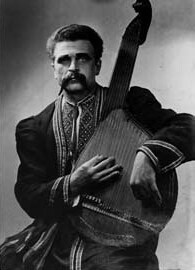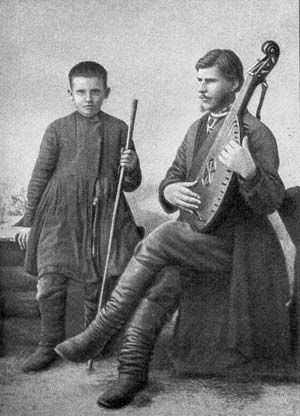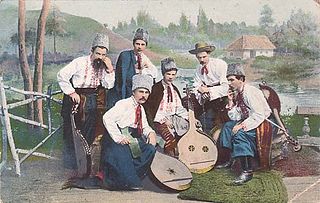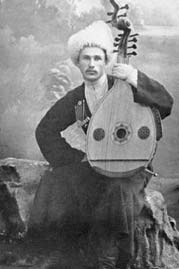
A bandura is a Ukrainian plucked-string folk-instrument. It combines elements of the zither and lute and, up until the 1940s, was also often called a kobza. Early instruments had 5 to 12 strings and resembled lutes. In the 20th century, the number of strings increased initially to 31 strings (1926), then to 56 strings – 68 strings on modern "concert" instruments (1954).

A bandurist is a person who plays the Ukrainian plucked string instrument known as the bandura.

Hnat Martynovych Khotkevych was a Ukrainian theater and public figure, engineer, inventor, writer, historian, translator, ethnographer, art critic, playwright, screenwriter, composer, musicologist, violinist, pianist, baritone, bandurist, and teacher. He was shot by the KGB during the Great Terror in the Soviet Union.
The Poltava Bandurist Capella was vocal-instrumental ensemble who accompanied themselves on the multi-stringed Ukrainian bandura. It was initially established in February 1925, based on a male church choir who sang in the Ukrainian Autocephalous Orthodox Cathedral in Poltava under the direction of Fedir (Khvedir) Popadych. The ensemble was disbanded in October 1934.

Ivan Iovych Kuchuhura-Kucherenko was a Ukrainian minstrel (kobzar) and one of the most influential kobzars of the early 20th century. For his artistry he was awarded the title "People's artist of Ukraine" in 1919 and later "People's Artist of the Ukrainian Soviet Socialist Republic" in 1926.

The Kyiv Bandurist Capella is a male vocal-instrumental ensemble that accompanies its singing with the playing of the multi-stringed Ukrainian folk instrument known as the bandura.
Leonid Haydamaka has left his impression on the development of bandura art in the 20th century.
Kobzars and bandurists were a unique class of musicians in Ukraine, who travelled between towns and sang dumas, a meditative poem-song. Kobzars were usually blind, and required the completion of a three-year apprenticeship in specialized Kobzar guilds, in order to be officially recognized as such. In 1932, on the order of Stalin, the Soviet authorities called on all Ukrainian Kobzars to attend a congress in Kharkiv. Those that arrived were taken outside the city and were all put to death.

Volodymyr Andryievych Kabachok was a well-known bandura player and educator in Ukraine.

Vasyl' Kostovych Yemetz was a Ukrainian bandurist. He was founder and initial director of the Kobzar Choir in 1918 - the direct protégé of the Kiev Bandurist Capella and the Ukrainian Bandurist Chorus.

Hryhory Ivanovych Bazhul was a Ukrainian bandurist and publisher of articles on bandura history from Poltava, Russian Empire. After World War II he emigrated to Australia settling in Sydney.

The Combined Kiev Bandurist Capella, also known as the Ukrainian State Exemplary Bandurist Capella, was a Ukrainian bandurist ensemble in the Soviet Union which existed from 1935 to 1941, until it was disbanded due to World War II.

Victor Mishalow is an Australian-born Canadian bandurist, educator, composer, conductor, and musicologist.
Peter Deriashnyj is a Ukrainian Australian bandurist, composer of secular and sacred music, and choral conductor. He specializes in the Kharkiv style of bandura playing, but also plays folk and rock guitar.
A Kuban bandurists is a person who plays the Ukrainian plucked string instrument known as the bandura, who is from Kuban, a geographic region of southern Russia surrounding the Kuban River.
The Chernihiv musical instruments factory was a factory founded to make stringed instruments in Ukraine. It is named after Soviet politician Pavel Postyshev.
The Honcharenko Brothers—Alexander (1913–2005) and Peter —became the dominant bandura-makers and designers in the Ukrainian diaspora.
The Leontovych Bandurist Capella was a male choir whose members accompanied themselves using a Ukrainian folk instrument known as a bandura. It was established in the displaced persons camps in Germany in 1946 and had an active performance schedule until 1949.
Kharkiv-style banduras are banduras that allow for the playing of the Kharkiv style, i.e. using the left hand to play melodic figures primarily over the side of the instrument as opposed to the Kyiv style where the left hand primarily plays the basses. To allow for the added required dexterity of the left hand, the instrument is held parallel to the body of the player.

The Hnat Khotkevych Ukrainian Bandurist Ensemble is a vocal and instrumental Ukrainian folkloric performing ensemble in Sydney, Australia. It was founded in June 1964 by bandurist Hryhory Bazhul and since May 1971 was directed by Peter Deriashnyj.
Cheremesky, K. Povernennia Tradytsiyi - Kharkiv, 1999.







